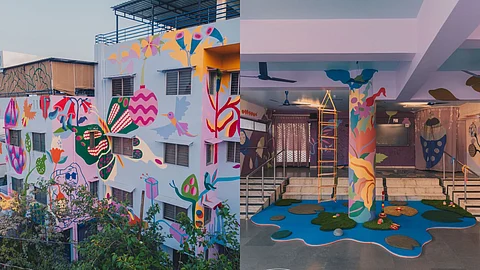
- HOMEGROWN WORLD
- #HGCREATORS
- #HGEXPLORE
- #HGVOICES
- #HGSHOP
- CAREERS
- ABOUT US
- CONTACT US

At first glance, the soaring butterfly mural by artists Amrit Khurana and Anikesa Dhing on the façade of Arpan Charitable Trust, a school for neurodiverse children in Vadodara, catches your eye with its vibrant colours. But step inside, and it becomes something more — a metaphor for transformation made literal. The mural symbolises the transformative journey of a child emerging and coming into their own from the nurturing cocoon of safe spaces like Arpan. Developed through a co-creation process with students at the school led by Access For ALL founder Siddhanth Shah, it is a gentle reminder of the beauty of growth and the endless potential in every neurodiverse child.
The mural is only the outer surface of Project Udaan — Hindi for 'flight' — a collaboration between Asian Paints, the St+art India Foundation, and the Vadodara-based nonprofit organisation and education centre for children on the autism spectrum, Down syndrome, cerebral palsy and other developmental differences — groups whose sensory sensitivities are often overlooked.
At its core, Udaan is a pioneering sensory art and design intervention. Launched in April 2025, the initiative turned a common space inside the school into an interactive arena that stimulates and soothes neurodiverse students by integrating thoughtfully curated textures, colours, and interactive surfaces. The initiative aims to foster more awareness of neurodiversity and redefine the learning environment for neurodiverse children by creating spaces that enhance engagement, sensory regulation, and self-expression.
The initiative is a prime example of 'neuro-inclusive design', an approach that "actively supports and enables persons across the full spectrum of human neurodiversity". In practice, this meant curating colours, textures, and lights to ease sensory demands. Drawing on Khurana's own experience with autism and her work with structured patterns and rhythmic textures and Dhing's knowledge of material contrasts, Project Udaan uses material and colour innovation to incorporate textures and matte emulsions in pastel shades and tactile Nilaya fabrics and wallpapers to create a multi-sensory experience.
"By integrating textures that respond to touch and materials that support sensory needs, we've built a space that adapts to children, rather than the other way around."
Amit Syngle, MD & CEO, Asian Paints
These tactile, interactive surfaces allow neurodiverse children to trace, feel, and engage with their immediate surroundings offering both stimulation and grounding. The matte finishes minimise glare for visual comfort, while Nilaya fabrics provide structured yet dynamic visual cues. Additionally, sensory rugs and textured surfaces work together to enhance sensory awareness and motor skills. From interactive learning and play areas to cocoon-like structures that help students decompress, the intervention adapts to individual sensory needs, creating a space where every child feels secure and inspired.
"Project Udaan transforms art from a decorative element to an interactive experience, creating familiarity and comfort for neurodivergent children. This initiative is about rethinking how creative interventions can transform everyday spaces into something more intuitive and inclusive. At its heart, Udaan embodies 'Art For All', where design is a language that speaks to everyone, regardless of how they see or experience the world."
Arjun Bahl, Co-Founder, St+art India Foundation
Today, Project Udaan serves as the prototype for a scalable model for designing neurodivergent-friendly learning spaces. By integrating art, materiality, and sensory design, it challenges conventional learning environments, demonstrating how walls, colours, and textures can actively support engagement and comfort.
Find out more about Project Udaan by Asian Paints and St+art India here:
Follow St+art India here.
